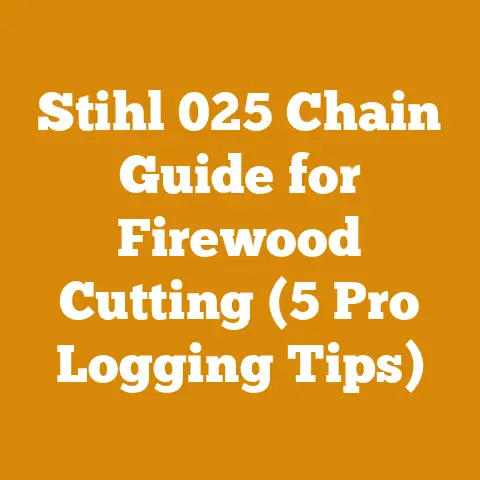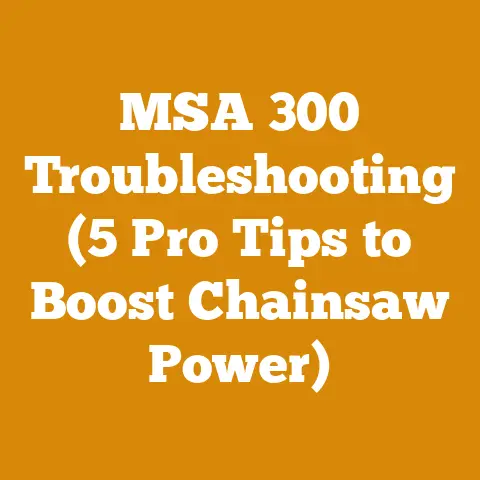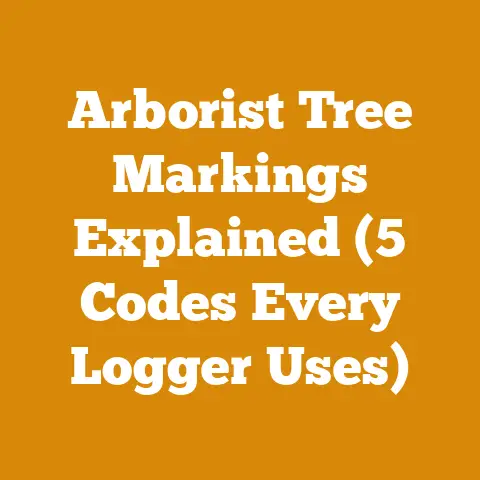Carpenter Ant Dust Pile (5 Signs You Must Know)
Timeless problems require timeless solutions. The battle against wood-destroying insects, like carpenter ants, is one such timeless struggle. Every seasoned woodworker, homeowner, and even the casual firewood enthusiast has likely encountered the tell-tale sign of these persistent pests: the dreaded carpenter ant dust pile. But what does it really mean? What are the early warning signs you might be missing? And how can you protect your precious lumber, your home, and even your firewood from these silent destroyers?
Over the years, I’ve felled countless trees, processed tons of firewood, and built my fair share of structures, both big and small. Along the way, I’ve learned to respect the power of nature – both its beauty and its destructive potential. Carpenter ants, with their ability to hollow out wood from the inside, definitely fall into the latter category.
Here’s what we’ll cover:
- The 5 Key Signs of Carpenter Ant Activity: Beyond the dust pile, I’ll reveal the subtle clues that often go unnoticed.
- Understanding Carpenter Ant Behavior: Learn what attracts them, how they nest, and why they target your wood.
- Distinguishing Carpenter Ants from Termites: Don’t mistake one for the other! Accurate identification is crucial.
- DIY Inspection Techniques: I’ll show you how to conduct a thorough inspection of your property.
- Effective Control and Prevention Strategies: From natural remedies to professional treatments, we’ll explore your options.
So, grab a cup of coffee (or maybe something stronger – you might need it!), and let’s dive into the world of carpenter ants. This isn’t just about identifying a dust pile; it’s about protecting your investments and preserving the integrity of your wood for years to come.
Carpenter Ant Dust Pile: 5 Signs You Must Know
The carpenter ant dust pile is the most obvious indicator of an infestation. But there are a number of other signs that can help you identify an infestation early.
1. The Obvious Sign: Carpenter Ant Dust Piles (Frass)
The most recognizable sign of carpenter ant activity is the presence of dust piles, often referred to as “frass.” This isn’t your average household dust. It’s a coarse, granular material that looks like fine sawdust mixed with insect parts.
- What it is: Carpenter ants don’t eat wood. Instead, they excavate it to create nests. The frass is the byproduct of this excavation process. It’s composed of wood shavings, insect body parts, and sometimes even dead ants.
- Where to look: These piles are typically found near carpenter ant entry points and nesting sites. Common locations include:
- Along baseboards
- Underneath window sills
- In crawl spaces and attics
- Near wooden beams and support structures
- Around decks and porches
- My Experience: I remember one time, I was helping a friend renovate an old barn. We kept finding these small piles of frass near the foundation. At first, we thought it was just debris from the construction. But when we started finding dead ants mixed in, the alarm bells started ringing. Sure enough, we discovered a significant carpenter ant nest inside a rotted support beam.
- Key Takeaway: Don’t dismiss unexplained dust piles, especially if they’re near wood. Investigate further to determine if carpenter ants are the culprit.
2. The Auditory Clue: Rustling or Clicking Sounds
Carpenter ants are surprisingly noisy creatures, especially when they’re actively excavating wood. If you listen closely, you might be able to hear them at work.
- What to listen for:
- Rustling sounds: This is the sound of ants moving within their nests, especially if the infestation is large.
- Clicking or tapping sounds: These sounds are produced when ants communicate with each other, often by tapping their mandibles against the wood.
- How to listen: The best time to listen for these sounds is at night, when the house is quiet. Place your ear against walls, floors, or wooden structures that you suspect might be infested. You can also use a stethoscope to amplify the sounds.
- My Experience: I once had a client who complained of a strange clicking noise coming from her bedroom wall at night. She thought it was mice. But after a thorough inspection, I discovered a large carpenter ant nest within the wall cavity. The clicking sound was the ants communicating.
- Key Takeaway: Unusual noises coming from within your walls or wooden structures could be a sign of carpenter ant activity. Don’t ignore them!
3. The Visual Confirmation: Carpenter Ant Sightings
Seeing carpenter ants themselves is a clear indicator of an infestation. However, it’s important to distinguish them from other types of ants.
- Identifying Carpenter Ants:
- Size: Carpenter ants are larger than most other household ants, typically ranging from 1/4 inch to 3/4 inch in length.
- Color: They can be black, red, brown, or a combination of these colors.
- Waist: Carpenter ants have a distinctly narrow waist (petiole) between their thorax and abdomen.
- Elbowed Antennae: Their antennae are bent or elbowed.
- Where to look: Carpenter ants are most active at night. Look for them foraging for food in kitchens, bathrooms, and other areas where food and water are available. You might also see them trailing along walls, floors, or ceilings.
- My Experience: I remember one summer, I kept finding large black ants in my kitchen, especially around the sink. I initially dismissed them as just regular ants. But when I started seeing them near a leaky window sill, I realized they were carpenter ants. They were using the moisture from the leak to build their nest.
- Key Takeaway: If you see large ants indoors, especially at night, take a closer look. They could be carpenter ants.
4. The Structural Weakness: Damaged or Hollow Wood
Carpenter ants excavate wood to create nests, which can weaken the structural integrity of wooden structures.
- What to look for:
- Hollow sounds: Tap on wooden structures with a hammer or screwdriver. If the wood sounds hollow, it could be a sign of carpenter ant damage.
- Soft or spongy wood: Probe wooden structures with a screwdriver. If the wood is soft or spongy, it could be a sign of rot and carpenter ant infestation.
- Visible galleries: In severe cases, you might be able to see the galleries (tunnels) that carpenter ants have created within the wood.
- My Experience: I was once hired to inspect a deck that was showing signs of rot. As I was probing the wood with a screwdriver, I noticed that it was unusually soft in certain areas. When I dug deeper, I discovered a network of carpenter ant galleries running throughout the deck supports. The ants had significantly weakened the structure, making it unsafe.
- Key Takeaway: Structural weakness in wooden structures could be a sign of carpenter ant damage. Don’t ignore it, especially if you also see other signs of infestation.
5. The Swarm: Flying Ants (Reproductives)
The presence of flying ants, also known as swarmers or reproductives, is a strong indicator of a mature carpenter ant colony nearby.
- What are swarmers? Swarmers are winged carpenter ants that emerge from the nest to mate and establish new colonies.
- When do they swarm? Carpenter ants typically swarm in the spring or early summer, when the weather is warm and humid.
- Where to look: Swarmers are often attracted to light. You might find them near windows, doors, or light fixtures.
- My Experience: I once had a client who found dozens of flying ants in her living room. She was understandably alarmed. After a thorough inspection, I discovered a large carpenter ant colony in the attic. The swarmers were trying to escape and establish new colonies.
- Key Takeaway: Seeing swarmers indoors is a serious sign of a mature carpenter ant colony nearby. It’s time to call in a professional.
Understanding Carpenter Ant Behavior: What Attracts Them?
Knowing what attracts carpenter ants can help you prevent infestations in the first place. Here are some key factors:
- Moisture: Carpenter ants are attracted to moist or damp wood. Leaky roofs, plumbing leaks, and poor drainage can create ideal conditions for them to thrive.
- Decaying Wood: Soft, decaying wood is easier for carpenter ants to excavate. Rotting decks, fences, and siding are prime targets.
- Food Sources: Carpenter ants feed on a variety of foods, including sweets, meats, and other insects. Leaving food crumbs and spills around your home can attract them.
- Access Points: Carpenter ants can enter your home through cracks in the foundation, gaps around windows and doors, and other small openings.
- Vegetation: Overhanging tree branches and shrubs can provide carpenter ants with a bridge to your home.
Distinguishing Carpenter Ants from Termites: A Crucial Difference
It’s essential to distinguish carpenter ants from termites, as the treatment methods are different. Here’s a quick comparison:
| Feature | Carpenter Ants | Termites |
|---|---|---|
| Body Shape | Narrow waist, elbowed antennae | Straight waist, straight antennae |
| Wings | Front and hind wings are different lengths | Front and hind wings are the same length |
| Damage | Clean, smooth tunnels in wood | Mud-filled tunnels in wood |
| Frass | Coarse, granular, contains insect parts | Fine, powdery, resembles sawdust |
| Diet | Do not eat wood, excavate it for nesting | Eat wood |
DIY Inspection Techniques: Finding the Source
Conducting a thorough inspection is crucial for identifying the extent of the infestation and locating the nest. Here’s how to do it:
- Start with the exterior: Inspect the foundation, siding, decks, fences, and other wooden structures for signs of damage or entry points.
- Check for moisture: Look for leaky roofs, plumbing leaks, and poor drainage.
- Inspect the interior: Focus on areas where you’ve seen ants or found frass. Check baseboards, window sills, attics, and crawl spaces.
- Use a flashlight and screwdriver: Use a flashlight to illuminate dark areas and a screwdriver to probe for soft or hollow wood.
- Listen for sounds: Place your ear against walls and wooden structures to listen for rustling or clicking sounds.
Effective Control and Prevention Strategies: Taking Action
Once you’ve identified a carpenter ant infestation, it’s time to take action. Here are some effective control and prevention strategies:
- Eliminate Moisture Sources: Fix leaky roofs, plumbing leaks, and improve drainage.
- Remove Decaying Wood: Replace rotting decks, fences, and siding.
- Seal Entry Points: Caulk cracks in the foundation, gaps around windows and doors, and other small openings.
- Trim Vegetation: Trim overhanging tree branches and shrubs.
- Use Insecticides: Apply insecticides to areas where you’ve seen ants or found frass. Boric acid is a natural and effective option.
- Professional Treatment: For severe infestations, it’s best to call in a professional pest control company.
My Final Thoughts: Protecting Your Wood and Home
Carpenter ants can be a real nuisance, but with a little knowledge and effort, you can protect your wood and home from these destructive pests. Remember to be vigilant, inspect your property regularly, and take action at the first sign of infestation. Don’t let carpenter ants turn your wood into sawdust!
By understanding the signs, behavior, and control methods of carpenter ants, you can take proactive steps to prevent infestations and protect your valuable investments. Remember to always prioritize safety and follow the instructions on any insecticide products you use.
And if you’re ever in doubt, don’t hesitate to call in a professional. They have the expertise and equipment to handle even the most severe carpenter ant infestations. Good luck, and happy woodworking!






